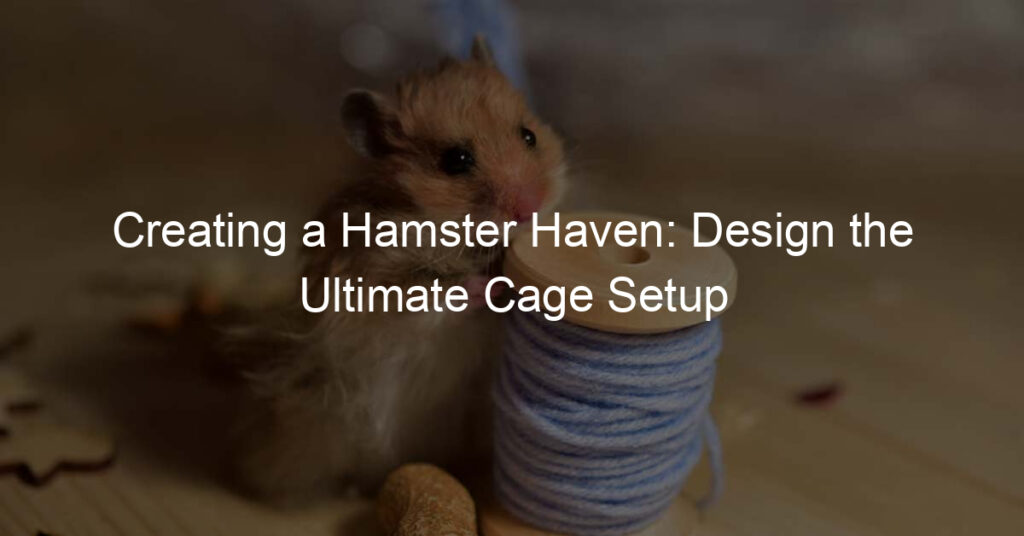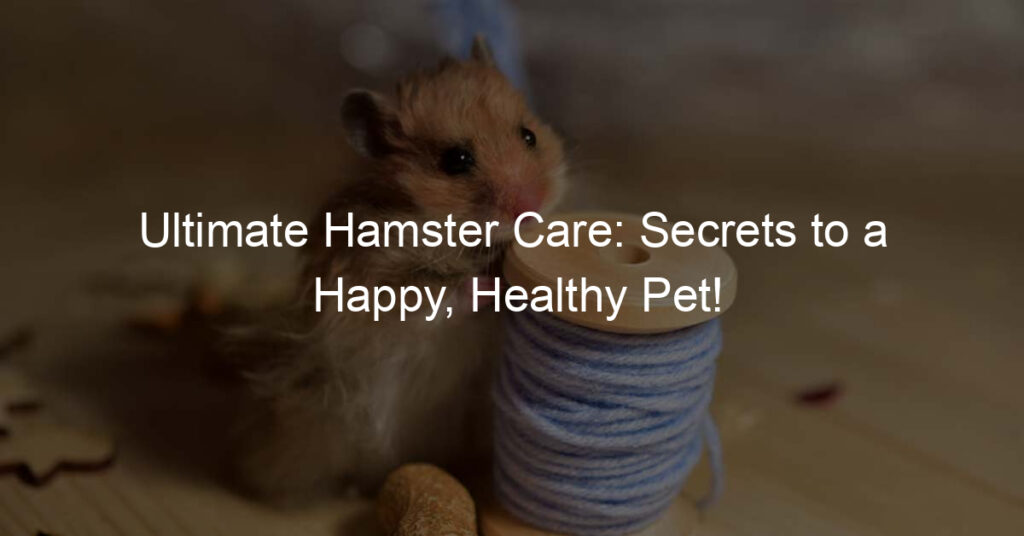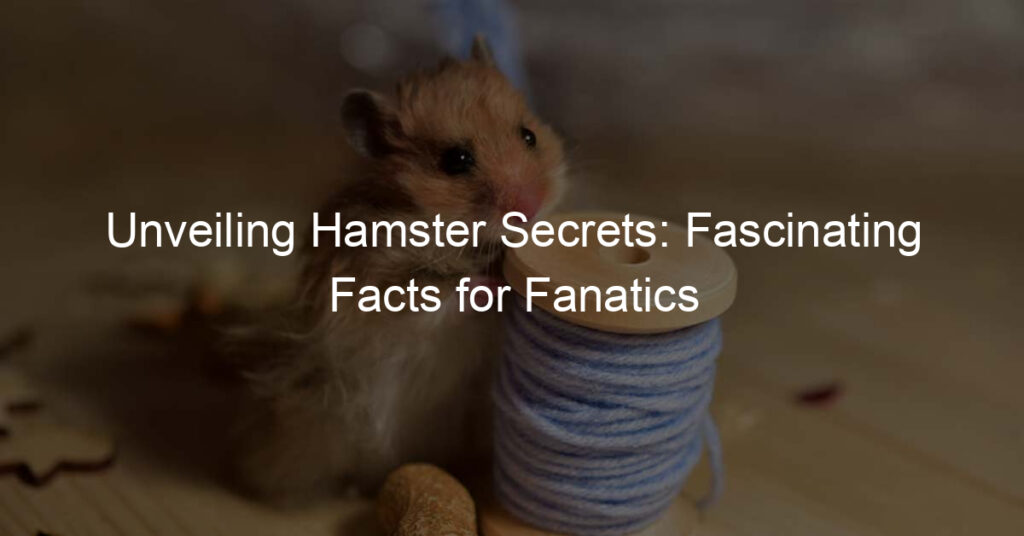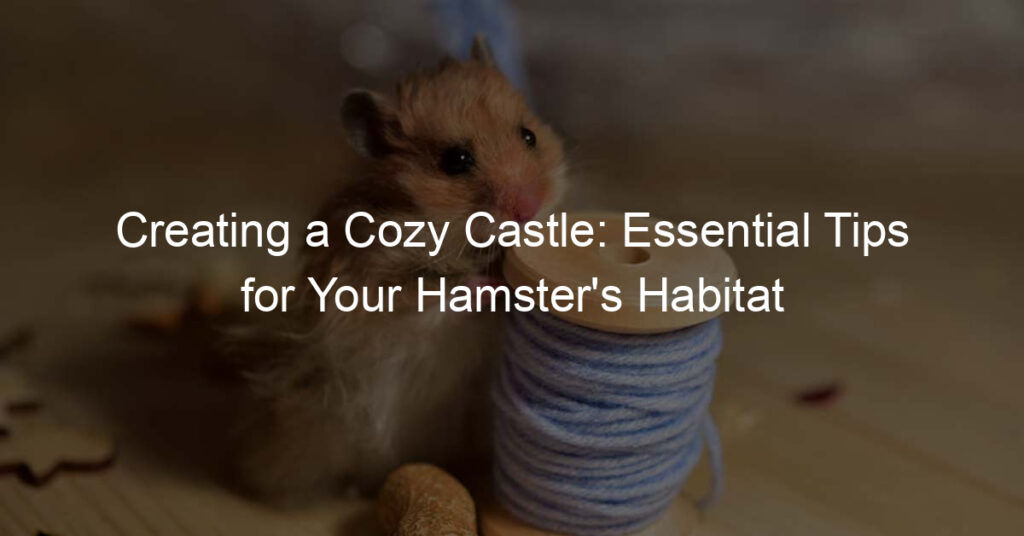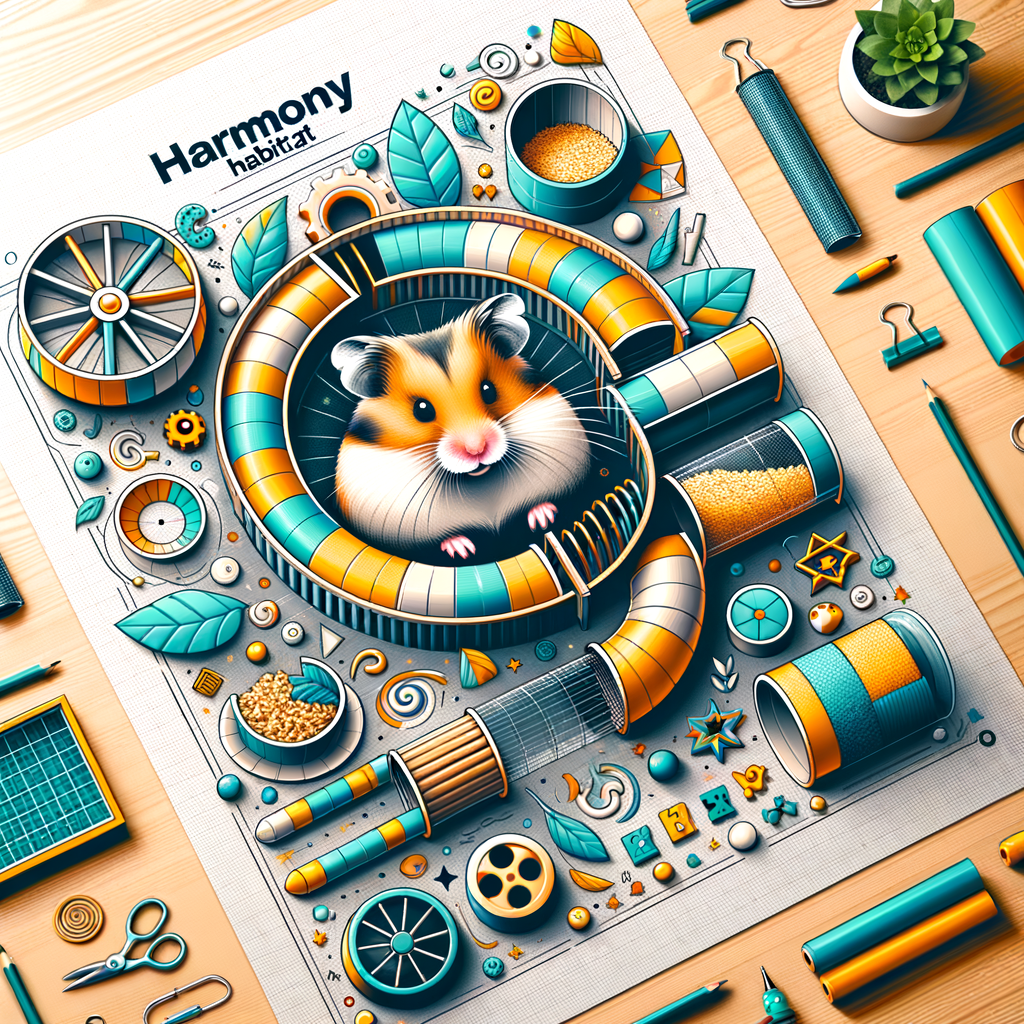
Introduction to Hamster Cage Design
Designing a hamster cage might seem like a simple task, but it requires careful thought and planning. The habitat you create for your hamster plays a crucial role in its health, happiness, and overall well-being. In this article, we will delve into the importance of a well-designed hamster habitat and the key factors to consider in hamster cage setup.
- Understanding the Importance of a Well-Designed Hamster Habitat
Hamsters are active and curious creatures. They need a habitat that caters to their natural instincts and behaviors. A well-designed hamster cage can provide a safe, comfortable, and stimulating environment for your pet.
Research shows that hamsters housed in well-designed cages are healthier and live longer. They are less likely to develop stress-related diseases and behavioral issues. They also tend to be more active and display natural behaviors, such as burrowing and foraging, which are essential for their mental and physical health.
- Key Factors to Consider in Hamster Cage Setup
When setting up a hamster cage, there are several key factors to consider. These include the size of the cage, the type of bedding, the placement of food and water dishes, the inclusion of toys and exercise equipment, and the arrangement of hiding and sleeping areas.
| Factor | Description |
|---|---|
| Size of the cage | The cage should be spacious enough for your hamster to move around freely. The minimum recommended size is 450 square inches of floor space. |
| Type of bedding | Hamsters need soft, absorbent bedding for burrowing and nesting. Avoid cedar and pine shavings, as they can cause respiratory problems. |
| Placement of food and water dishes | Place food and water dishes in easily accessible areas. Ensure they are not placed under any high platforms or toys where they could be soiled. |
| Inclusion of toys and exercise equipment | Hamsters need toys and exercise equipment, such as tunnels, wheels, and chew toys, to keep them entertained and active. |
| Arrangement of hiding and sleeping areas | Provide multiple hiding and sleeping areas for your hamster. These can be commercial hamster houses or simple cardboard boxes. |
By understanding the importance of a well-designed hamster habitat and considering the key factors in hamster cage setup, you can create a home that will keep your hamster happy, healthy, and engaged.
Creating the Perfect Hamster Habitat
Creating the perfect habitat for your hamster involves many factors, but one of the most important is choosing the right cage. The cage is your hamster’s home and it should be comfortable, safe, and easy to maintain. Here are some key factors to consider when choosing a hamster cage.
Choosing the Right Cage
- Size and Space Considerations for Ideal Hamster Cage
- Material and Build Quality
- Accessibility and Ease of Cleaning
Hamsters need plenty of space to move around and play. A cage that is too small can lead to stress and health problems. The minimum recommended size for a hamster cage is 450 square inches of floor space, but bigger is always better. Remember, your hamster will spend most of its life in this cage, so make sure it has plenty of room to explore and exercise.
The material of the cage is also important. Wire cages are popular because they provide good ventilation, but make sure the bars are close enough together that your hamster can’t squeeze through. Plastic cages can be fun and colorful, but they should be sturdy and not easily chewable. Glass aquariums are another option, providing good visibility and security, but they can be heavy and harder to clean.
Hamsters are clean animals and they need a clean environment to stay healthy. Choose a cage that is easy to access for cleaning. It should have a large door or a removable top. Also, consider how easy it is to remove and replace bedding and other cage accessories. A cage that is difficult to clean can lead to a dirty environment and potential health issues for your hamster.
In conclusion, choosing the right cage is a crucial step in creating the perfect hamster habitat. Consider the size, material, and accessibility of the cage to ensure your hamster has a comfortable and healthy home.
Designing the Interior
When it comes to creating the perfect hamster habitat, designing the interior plays a crucial role. It’s not just about making the cage look good, but also about ensuring your hamster’s comfort and happiness. Let’s delve into the details.
- Creating harmony in hamster habitat with appropriate toys and accessories
- Importance of exercise wheels, tunnels, and hideouts
Creating a harmonious environment for your hamster involves more than just a clean cage. It’s about providing them with the right toys and accessories that cater to their natural instincts and behaviors. For instance, hamsters are natural burrowers, so providing them with a variety of tunnels can help them feel at home. Similarly, chew toys are essential for hamsters as they help maintain their dental health. Remember, the key is to choose toys and accessories that are safe and suitable for your hamster’s size.
Exercise wheels, tunnels, and hideouts are not just accessories, but necessities for your hamster’s well-being. Exercise wheels provide the much-needed physical activity to keep your hamster healthy and prevent obesity. Tunnels mimic their natural burrowing behavior, providing them with a sense of security and fun. Hideouts, on the other hand, offer a safe and cozy spot for your hamster to rest and sleep. It’s crucial to ensure these elements are made of safe, chewable materials and are of appropriate size.
Designing the interior of your hamster’s habitat is a fun and rewarding process. It allows you to tap into your creativity while ensuring your pet’s comfort and happiness. Remember, a well-designed habitat can significantly enhance your hamster’s quality of life.
| Accessory | Benefit |
|---|---|
| Toys | Stimulates mental activity and prevents boredom. |
| Exercise Wheels | Provides physical exercise and prevents obesity. |
| Tunnels | Mimics natural burrowing behavior and provides fun. |
| Hideouts | Offers a safe and cozy spot for rest and sleep. |
Hamster Cage Setup: Practical Tips
Creating a comfortable and safe environment for your hamster is crucial for their health and happiness. One of the most important aspects of this setup is the bedding and nesting material. Let’s explore some practical tips on how to choose and provide these essentials.
Bedding and Nesting Material
Bedding and nesting material play a significant role in your hamster’s cage setup. They not only provide comfort but also contribute to the hamster’s natural behavior of burrowing and nesting. Here are some key points to consider:
- Choosing safe and comfortable bedding
- Providing nesting material for hamster’s comfort
When it comes to bedding, safety and comfort are paramount. Opt for paper-based or aspen wood shavings as they are safe for hamsters. Avoid cedar or pine shavings as they can cause respiratory issues. The bedding should be absorbent and odor-free to maintain a clean environment. It should also be soft to prevent injuries to your hamster’s feet.
Nesting material is essential for your hamster’s comfort and warmth. You can provide unscented tissues or paper towels that your hamster can shred and arrange to their liking. Avoid materials like cotton wool that can cause digestion problems if ingested. Always ensure the nesting material is dry to prevent the growth of mold and bacteria.
Remember, a comfortable hamster is a happy hamster. By providing the right bedding and nesting material, you are contributing to their well-being and promoting natural behaviors. This will result in a healthier, more active, and happier pet.
Food and Water Arrangement
One of the most important aspects of creating a comfortable habitat for your hamster is the proper arrangement of food and water. This includes both the placement of food bowls and water bottles, as well as maintaining a regular cleaning and refilling schedule.
- Placement of Food Bowls and Water Bottles
- Regular Cleaning and Refilling Schedule
When placing your hamster’s food bowl and water bottle, it’s important to consider their natural behaviors. Hamsters like to forage for their food, so placing the bowl in a spot where they can easily access it is crucial. The water bottle should be placed at a height that is comfortable for your hamster to reach, usually at the level of their shoulders.
Keeping your hamster’s food and water clean is just as important as the placement. Hamsters are very clean animals and a dirty food bowl or water bottle can lead to health problems. It’s recommended to clean and refill the food bowl and water bottle every day. This not only ensures that your hamster has fresh food and water, but also helps to keep their cage clean and free from bacteria.
In conclusion, the proper arrangement of food and water is a key factor in creating a comfortable and healthy habitat for your hamster. By considering their natural behaviors and maintaining a regular cleaning and refilling schedule, you can ensure that your hamster is happy and healthy.
Harmony in Hamster Habitat: Case Studies
Let’s delve into some real-life examples of how to create a harmonious hamster habitat. These case studies will provide practical insights and solutions to common challenges faced by hamster owners.
- Case Study 1: Designing Hamster Cages for Multiple Hamsters
- Case Study 2: Overcoming Challenges in Small Spaces
Meet Sarah, a hamster enthusiast who owns three adorable hamsters. She faced a challenge when she decided to house all three hamsters in one cage. The key was to create a habitat that provided enough space and resources for all her pets.
She started by choosing a large cage with multiple levels. Each level was equipped with a separate sleeping area, food bowl, and water bottle. This ensured that each hamster had its own space and resources, reducing potential conflicts.
She also added multiple toys and exercise wheels to keep her pets entertained and active. The result? Her hamsters are now living happily together in their spacious, well-equipped habitat.
Next, let’s look at John, who lives in a small apartment but wanted to provide a comfortable habitat for his hamster. He had to be creative to overcome the space constraints.
John opted for a vertical cage design, which provided ample space for his hamster without taking up too much room in his apartment. He also made good use of the vertical space by adding climbing toys and hammocks.
Despite the small space, John was able to create a habitat that met all his hamster’s needs. His hamster now enjoys a fun and stimulating environment, proving that even in small spaces, it’s possible to create a great hamster habitat.
These case studies show that with some creativity and careful planning, you can create a harmonious habitat for your hamsters, regardless of the number of pets or the size of your living space.
Designing Perfect Hamster Habitat: Key Takeaways
As we conclude our discussion on creating the perfect hamster habitat, it’s important to remember the key aspects that contribute to a healthy and comfortable environment for your furry friend. Let’s recap the main points:
- Understanding hamster’s needs is crucial in cage design: Every hamster is unique and has specific needs. Some hamsters prefer running on wheels, while others enjoy burrowing or climbing. Understanding these needs will guide you in selecting the right cage design and accessories. For instance, a hamster who loves to burrow will appreciate a cage with a deep base for bedding.
- Regular maintenance and cleaning ensure a healthy habitat: Hamsters are clean animals, and a dirty cage can lead to health problems. Regular cleaning, including removing old food and soiled bedding, is essential. A weekly deep clean, where you remove and replace all bedding and clean the cage and accessories with a pet-safe disinfectant, will keep your hamster’s home fresh and healthy.
- Proper cage setup contributes to hamster’s overall well-being: A well-set cage promotes physical activity and mental stimulation. It should include a quiet sleeping area, a space for eating and storing food, a play area with toys, and a toilet area. The cage should also be placed in a quiet, temperature-controlled area away from direct sunlight and drafts.
By keeping these key takeaways in mind, you can create a habitat that not only meets your hamster’s basic needs but also provides a stimulating and enriching environment. Remember, a happy hamster is a healthy hamster!
Conclusion: Your Hamster’s Perfect Cage Setup
In this article, we have journeyed through the fascinating world of hamster habitats. We’ve learned about the importance of a well-designed cage, and how it can significantly impact the health and happiness of our furry friends. Now, let’s recap and share some final thoughts on creating a hamster harmony habitat.
- Recap of the importance of a well-designed hamster cage
- Final thoughts on creating a hamster harmony habitat
Designing a perfect hamster cage is not just about aesthetics; it’s about creating a safe, comfortable, and stimulating environment for your hamster. A well-designed cage should provide ample space for movement, areas for play and exercise, and a quiet spot for rest. It should also be easy to clean and maintain. Remember, the key to a happy hamster is a well-designed cage!
Creating a hamster harmony habitat is all about understanding your hamster’s needs and preferences. Every hamster is unique, and what works for one might not work for another. The most important thing is to observe your hamster and adjust the habitat as needed. With patience, creativity, and a bit of research, you can create a habitat that your hamster will love and thrive in.
In conclusion, the perfect hamster cage setup is one that caters to your hamster’s physical and emotional needs. It’s a place where your hamster can play, rest, and explore safely. By following the tips and insights shared in this article, you are well on your way to creating a perfect home for your hamster. Remember, a happy hamster is a healthy hamster!

